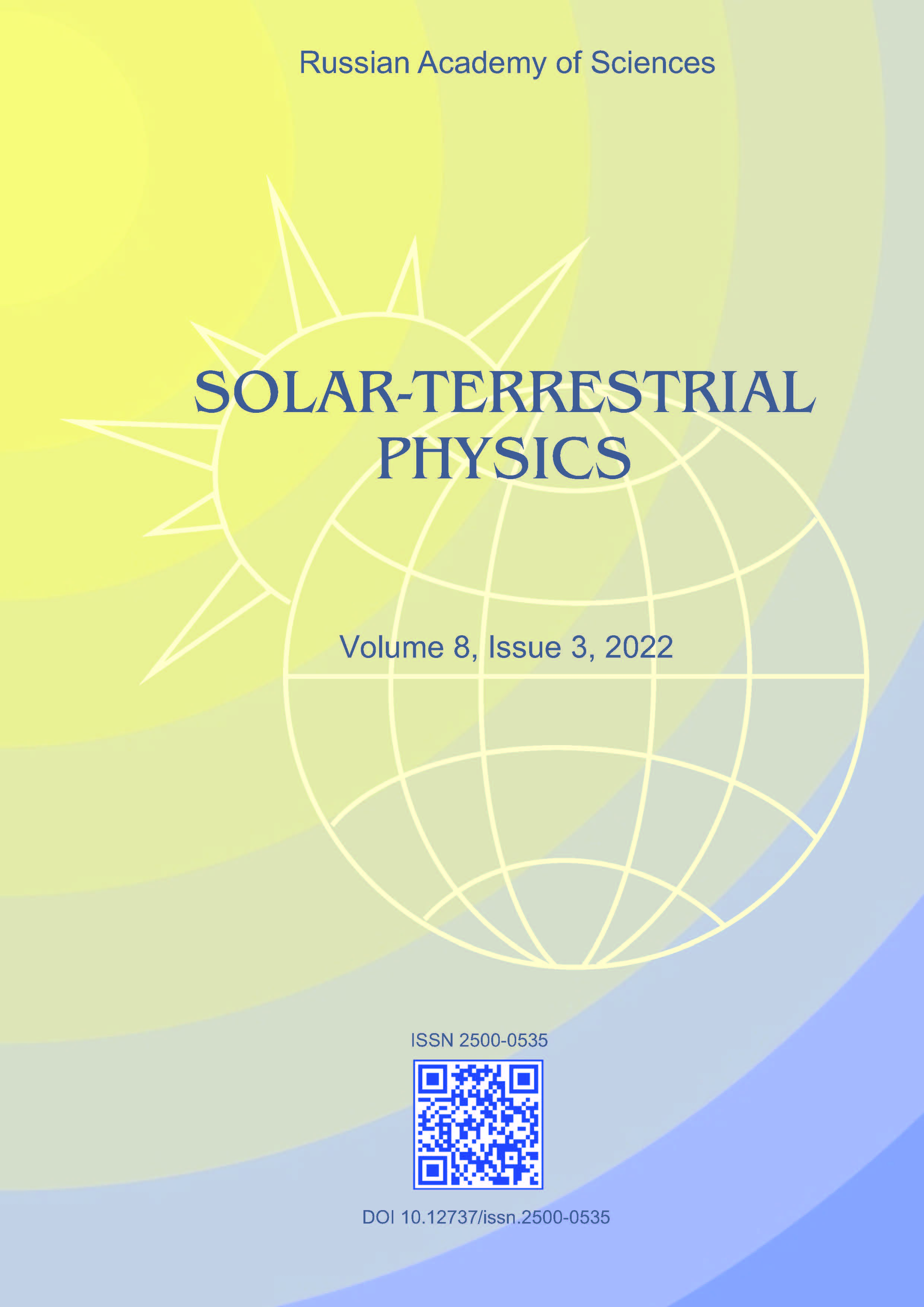Irkutsk, Russian Federation
The paper addresses color characteristics and possible spectral composition of emission of a long-lived (~40 min) meteor trail of uncommon geometry, which was formed due to the bolide passage in the Tunka Valley on November 17, 2017. Analysis of dynamics of RGB channels of the meteor trail colored image shows that during the first ~8 minutes the meteor trail emission might have been contributed by the ionization trail. The ionization trail was formed by particles of the meteor matter neutral and ionized components that were heated to high temperatures on the surface of the main meteoroid and separated from it. We also examine the discussed mechanism of heterogeneous chemical reactions occurring on the surface of meteoric dust (FeS, FeO, etc.) with participation of atoms and molecules of atmospheric gases. The yellowish color of the Tunka bolide meteor trail was assumed to be determined, first of all, by the emission of molecular nitrogen N₂ band within the 570–750 nm spectral range (the first positive system) and/or enhancement of NO*₂ continuum in heterogeneous chemical reactions. The meteor trail emission spectrum should also include relatively bright atomic lines and molecular bands of the meteoric matter and atmospheric gases FeI, MgI, CaI, SiI, NaI, FeO and SO₂, OI, OH, etc.
bolide, long-lived meteor trail, meteor trail color, meteor spectra
1. Astapovich I.S. Meteornye yavleniya v atmosfere Zemli [Meteor Phenomena in Earth’s Atmosphere]. Moscow, Nauka Publ., 1958, 640 p. (In Russian).
2. Babadzhanov P.B. Meteory i ikh nablyudeniya [Meteors and Their Observation]. Moscow, Nauka Publ., 1987, 176 p. (In Russian).
3. Baggaley W.J. The role of the oxides of meteoric species as a source of meteor train luminosity. Mon. Not. R. Astron. Soc. 1976, 174, pp. 617-620.
4. Bronsten V.A. Fizika meteornykh yavlenii [Physics of meteor phenomena]. Moscow, Nauka Publ., 1981. 416 p. (In Russian).
5. Clemesha B.R., F. de Medeiros A., Gobbi D., Takahashi H., Batista P.P., Taylor M.J. Multiple wavelength optical observations of a long-lived meteor trail. Geophys. Res. Lett. 2001, vol. 28, iss. 14, pp. 2779-2782. DOI:https://doi.org/10.1029/2000GL012605.
6. Fishkova L.M. Nochoye izluchenie sredneshirotnoi verkhei atmosfery Zemli [Nighttime Airglow of the Mid-Latitude Earth Upper Atmosphere]. Tbilisi, Metsniereba Publ., 1983, 271 p. (In Russian).
7. Grigoryan S.S. On the movement and destruction of meteorites in the atmospheres of the planets. Kosm. issled. [Cosmic Res.]. 1979, vol. 17, no. 6, pp. 875-893. (In Russian).
8. Ivanov K.I., Komarova E.S., Vasilyev R.V., Eselevich M.V., Mikhalev A.V. Meteor trail drift research based on baseline observations. Solar-Terr. Phys. 2019, vol. 5, iss. 1, pp. 77-81. DOI:https://doi.org/10.12737/stp-51201911.
9. Kelley M.C., Gardner C., Drummond J., Armstrong T., Liu A., X. Chu, Papen G., Kruschwitz C., Loughmiller P., Grime B., Engelman J. First observations of long-lived meteor trains with resonance lidar and other optical instruments. Geophys. Res. Lett. 2000, vol. 27, iss. 13, pp. 1811-1814. DOI:https://doi.org/10.1029/1999GL011175.
10. Koukal J., Srba J., Gorková S., Lenža1 L., Ferus M., Civiš S., et al. Meteors and meteorites spectra. Proc. IMC. Egmond, 2016, pp. 137-142.
11. Mikhalev A.V. Long-Living Meteoroids formed during radial expansion of large meteoroids. Cosmic Res. 2021, vol. 59, no. 6, pp. 469-474.
12. Mikhalev A.V., Podlesny S.V., Stoeva P.V. Night airglow in RGB mode. Solar-Terr. Phys. 2016, vol. 2, iss. 3, pp. 106-114. DOI:https://doi.org/10.12737/22289.
13. Mikhalev A.V., Beletsky A.B., Vasilyev R.V. Eselevich M.V., Ivanov K.I., Komarova E.S., et al. Long-lived meteor trails. Solar-Terr. Phys. 2019, vol. 5, iss. 3, pp. 109-116. DOI:https://doi.org/10.12737/stp-53201913.
14. Murade E. Heterogeneous chemical processes as a source of persistent meteor trains. Meteoritics and Planetary Sci. 2001, vol. 36, no. 9, pp. 1217-1224.
15. Silber E.A., Boslough M., Hocking W.K., Gritsevich M., Whitaker R.W. Physics of meteor generated shock waves in the Earth’s atmosphere - a review. Adv. Space Res. 2018, vol. 62, iss.3, pp. 489-532. DOI:https://doi.org/10.1016/j.asr.2018.05.010.
16. Shustov B.M., Ryhlova L.V. Asteroidno-kometnaya opasnost’: vchera, segodnya, zavtra [Asteroid-Comet Hazard: Yesterday, Today, Tomorrow]. Moscow, Fizmatlit Publ., 2010, 384 p. (In Russian).
17. Smirnov V.A. Spektry kratkovremennykh svetovykh yavlenii: Meteory (Spectra of Short-Term Light Phenomena: Meteors), Moscow, Fizmatlit, 1994, 208 p. (In Russian).
18. Vasilyev R.V., Syrenova T.E., Beletsky A.B., Artamonov M.F., Merzlyakov E.G., Podlesny A.V., Cedric M.V. Studying a long-lasting meteor trail from stereo images and radar data. Atmosphere. 2021, vol. 12, p. 841. DOI:https://doi.org/10.3390/atmos12070841.
19. Vojáček V., Borovička J., Koten P., Spurný P., Štork R. Catalogue of representative meteor spectra. Astron. Astrophys. 2015, vol. 580, id. A67, 31 p. DOI:https://doi.org/10.1051/0004-6361/201425047.
20. Zinn J., Drummond J. Formation of parallel meteor trail pairs as associated with their buoyant rise. Adv. Space Res. 2007, vol. 39, pp. 555-561. DOI:https://doi.org/10.1016/j.asr.2006.12.007.
21. URL: www.kodak.com/go/imagers (accessed April 27, 2022).
22. URL: http://ckp-angara.iszf.irk.ru (accessed April 27, 2022)

















